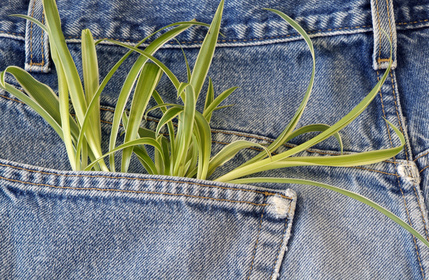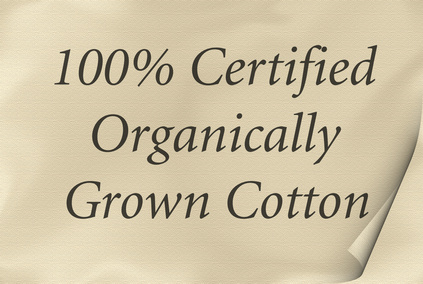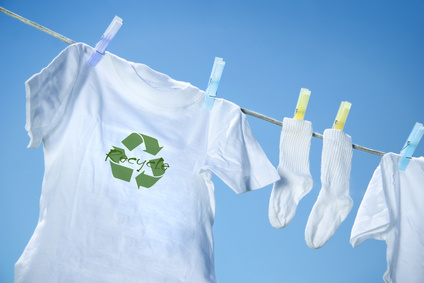Eco-Friendly Clothing and Green Fashion Tips

Of all your eco-friendly actions, none present a better opportunity for promoting green living than what you choose to wear. From hat to shoe, your wardrobe is a conversation piece. Every time someone asks, "Where did you get that?" there's your chance to to forward the green movement, one word-of-mouth wardrobe at a time.
- Avoid Dyed and Synthetic Fabrics
- Buy Garments Made Using Organic Fabrics
- What to Look for on a Label
- Buy Second-Hand, Vintage or Locally Made Garments
- Make Your Own Clothes
- Gently Wash and Dry Garments
- Green Your Bling
- Online Eco-Friendly Retailers
- Repair Garments to Increase Lifespan
Avoid Dyed and Synthetic Fabrics
When you wear fabrics treated with chemicals, you're exposing yourself to nano-particles small enough to be absorbed through the skin, not to mention the eyes, nose and mouth through indirect contact with your hands. Plus, one of our most valuable resources is used up during the chemical treatment process - water, which is used to dilute the chemicals for fabric application, then again for washing and rinsing out the chemicals. Of course, they are not washed away into oblivion, but make their way to our rivers and streams where these chemicals are ultimately incorporated into our drinking supply.
The most important synthetic fabrics to avoid include:
- Acetate
- Acrylic
- Nylon
- Polyester
- Polyvinyl chloride (PVC)
- Rayon
- Triacetate
Make an exception for secondhand or vintage clothing. It's already made and adding it to your wardrobe saves it from the landfill. Plus, these items have typically been washed countless times, thus diluting the chemicals in the fabric and minimizing the negative impact on your body. Return to Top
Buy Quality Garments Made From Organic Fabrics

Instead of opting for trendy, cheap fashion designed to wear out fast, invest in quality, timeless pieces made from sustainable fabrics that are made to last:
- Cotton
- Bamboo
- Hemp
- Ingeo (fermented plant sugars)
- Linen
- Lyocell (wood pulp)
Beyond the fabrics themselves, consider other elements involved in the manufacturing process. Ideally, thread should be organic and dyes vegetable-based. Also consider the factory's power source (i.e., solar vs. coal) and how waste is disposed. Granted, clothing labels do not generally list details of factory fuels or waste management, but you can ask these questions of manufacturers whose clothes, shoes or jewelry you are considering. Any good green-geared company should happily share the details of its manufacturing process. Return to Top
Look For These Labels
- Certified Organic
- Pesticide Free
- Untreated
- Uncolored
- Fair Trade
Choose Secondhand and Vintage
Every year, 98 percent of the clothes we throw away could still be worn. But because the fabric is faded or thinning, with a hole here or a button missing there, the vast majority of us write it off as waste. In celebration and support of those who make every effort to extend the life of their clothes (hopefully, yourself included), buy secondhand or vintage. From random neighborhood rummage sales, to thrift shops, to upscale vintage clothing stores, you can assemble a unique wardrobe of green clothes, shoes and jewelry that will be the envy of your most fashionable friends, family and colleagues. Plus, you'll surely save some green on name brands that would cost two to ten times as much brand new.
Buy Local
As with any product, the closer to home you can find it, the lower your carbon footprint. Buy Made in the USA or, even better, support local artisans. Look for their work in neighborhood retail shops, art festivals and flea markets. Return to Top
Make Your Own Fashion
An especially creative way to ensure eco-friendly fashion is to control the manufacturing process yourself. Invest in an Energy Star sewing machine (or vintage, secondhand model), buy organic fabrics and threads, and make your own clothes. You can follow patterns or play around with your own designs. If you've never sewn before, take a class. Scarves, wraps and skirts are fun, easy patterns to start. For more complicated designs, you may want to solicit the services of a tailor, or the help of a friend or family member who sews. This is not to imply you should make your entire wardrobe. It can be just one of many bricks in the road to greening your fashion sense. Return to Top
Gently Wash and Dry

One of the greatest threats to the environment associated with our clothes is the washing and drying process. Of the 50 common household appliances, only the electric furnace and central air conditioner use more energy than the clothes dryer. The clothes washer is number 18 on the list, which keep in mind only takes into account the electricity used to run the machine, not its water usage.
To green the washing and drying process:
- Run full loads
- Use cold water
- Air dry on a clothesline
- Wash less frequently, especially jeans
- Avoid buying anything "dry clean only"
Beyond the energy and water saved, these practices will help extend the life of your clothes as well. Return to Top
Green Your Bling
Mining of metals and stones represents one of our most destructive industrial practices, particularly as it relates to fashion. For instance, creating just one gold ring produces 2 tons of waste - waste that includes toxic substances that get washed away into our water supply. To green your bling, look for:
- Secondhand and vintage jewelry
- Recycled gold, silver and platinum jewelry
- Fairtrade metals and stones
Solicit These Online Retailers
Looking for eco-friendly fashion can be an overwhelming experience. Ecomall.com and HappyHippie.com are good places to start, both impressive, comprehensive directories of eco friendly products, including clothes and shoes. Both offer options for jewelry, as do BrilliantEarth.com and GreenOro.com which deal in eco friendly jewelry exclusively. Return to Top
Repair Your Clothes, Shoes, and Jewelry
There are a number of simple repairs you can make to your clothing yourself. Replace missing buttons, fix hems, patch holes in jeans, and yes, darn socks! For more complicated repairs, seek help from a professional, be it a tailor, jeweler or cobbler for your shoes. Return to Top
